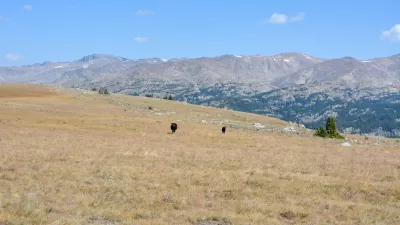In an news analysis for The New York Times Sunday Review, Alan Feuer sees the occupation of the Malheur National Wildlife Refuge in Harney County, Oregon as another struggle between the Wise Use movement, which began is the 1980s, and the mainstream.
"By storming the Malheur National Wildlife Refuge and vowing to return it — by force of arms, if necessary — to the people of Harney County, Mr. [Ammon] Bundy and his men were echoing the teachings, if not the tactics, of the Wise Use movement: a conservative land-use doctrine that has been a part of the national discourse for nearly 30 years," writes Alan Feuer, metropolitan reporter for The New York Times.
"The Wise Use Movement consists of more than a thousand local organizations across the country, representing roughly three million people—people who fear the infringement of their property rights, mostly by what they see as oppressive federal government regulations," write Jeffrey St. Clair and James Ridgeway for CounterPunch.
Feuer provides the background and historical perspective for the takeover of the refuge, operated by the U.S. Fish and Wildlife Service, rooted in the Wise Use movement.
Though composed of many activists and scores of organizations, Wise Use found its voice in the late 1980s when a timber industry adviser named Ron Arnold published “The Wise Use Agenda.” The manifesto offered an expansive plan to gut environmental regulation, increase private ownership of public land and compel the federal government to open its holdings to mining, oil and logging companies and to the unrestricted use of off-road vehicles.
Feuer warns readers from the onset not to dismiss rancher Ammon Bundy, son of Cliven Bundy who has yet to pay the Bureau of Land Management (BLM) the $1.2 million he owes in grazing fees, "as fanatics working at the fringes of American politics."
If you haven't been following the standoff near Burns, Oregon, The Times editorial board fills in the events of the last week:
Styling themselves as a militia, the group hijacked a peaceful protest over five-year prison sentences a federal court had imposed on two local ranchers for setting fires on federal land. Led by a man named Ammon Bundy — whose father, Cliven, instigated his own armed confrontation with federal authorities over cattle ranching in Nevada in 2014 — this hyperweaponized posse rolled into town and seized administrative buildings at the Malheur National Wildlife Refuge on Saturday [Jan. 2].
Jeffrey St. Clair and James Ridgeway write at length about those two ranchers, "Dwight Hammond [and his son Steven], now at the center of the armed seizure of the Malheur National Wildlife Refuge headquarters near Burns."
Feuer goes on to write about the intersection of the wise use and militia movements, interviewing, of all people, Jeffrey St. Clair, "a journalist who has written about environmental politics in the West for 30 years."
EcoWatch also provides a good accounting of the WiseUse nexus to the refuge takeover, as well as background on the refuge itself, "home to millions of migratory birds, established in 1908 by former President Theodore Roosevelt."
FULL STORY: The Ideological Roots of the Oregon Standoff

Planetizen Federal Action Tracker
A weekly monitor of how Trump’s orders and actions are impacting planners and planning in America.

Chicago’s Ghost Rails
Just beneath the surface of the modern city lie the remnants of its expansive early 20th-century streetcar system.

San Antonio and Austin are Fusing Into one Massive Megaregion
The region spanning the two central Texas cities is growing fast, posing challenges for local infrastructure and water supplies.

Since Zion's Shuttles Went Electric “The Smog is Gone”
Visitors to Zion National Park can enjoy the canyon via the nation’s first fully electric park shuttle system.

Trump Distributing DOT Safety Funds at 1/10 Rate of Biden
Funds for Safe Streets and other transportation safety and equity programs are being held up by administrative reviews and conflicts with the Trump administration’s priorities.

German Cities Subsidize Taxis for Women Amid Wave of Violence
Free or low-cost taxi rides can help women navigate cities more safely, but critics say the programs don't address the root causes of violence against women.
Urban Design for Planners 1: Software Tools
This six-course series explores essential urban design concepts using open source software and equips planners with the tools they need to participate fully in the urban design process.
Planning for Universal Design
Learn the tools for implementing Universal Design in planning regulations.
planning NEXT
Appalachian Highlands Housing Partners
Mpact (founded as Rail~Volution)
City of Camden Redevelopment Agency
City of Astoria
City of Portland
City of Laramie





























